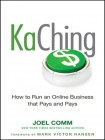KaChing: How to Run an Online Business that Pays and Pays Comm, Joel (books for 8th graders txt) 📖

Book online «KaChing: How to Run an Online Business that Pays and Pays Comm, Joel (books for 8th graders txt) 📖». Author Comm, Joel
If you know that a large number of people are going to be doing their Christmas shopping on Amazon on December 15, for example, then you could put up a blog post on that day with an affiliate link to a great gift. You could even support that post by including a reference to it and a link in an e-mail sent to your mailing list. Better still, you could hunt down a merchant that you know and trust and negotiate a discount code. That would allow you to create a time-limited offer—exactly the kind of thing that drives sales the most.
Instead of saying, “This product is great, and you should buy it,” you’ll be able to say, “This product is great, you should buy it, and I’ve managed to get you a discount. Enter this code within the next two days and you’ll save 10 percent.”
Because you’ll be striking at a time when you know people are planning to buy anyway, as long as the product is good, you should find that you make plenty of sales.
ASK FOR MORE MONEY!
One of the most interesting results that Shawn Collins turned up in his affiliate survey revealed a particularly effective strategy for increasing affiliate earnings ... asking the merchant for a higher affiliate commission.
According to the survey, 58 percent of respondents had successfully asked an affiliate manager for an increase in their commissions. Presumably, many of the 42 percent who said that they hadn’t successfully requested an increase hadn’t asked for one. Simply getting in touch with your affiliate manager and suggesting that you should be paid more can increase your earnings.
I suspect you’ll have to do a little more than say please, though. Affiliate managers are likely to be generous if you can point out how much money you’re making for them—and how much more money you could be making for a competitor who has a slightly better program than theirs. Don’t beg. Just point out that their program is no longer competitive and that you’re making enough money for them that they should keep you on board.
If Shawn Collins’s survey is anything to go by, that should be enough to land you higher commissions.
What the FTC’s Guidelines Mean for Affiliates
On December 1, 2009, the Federal Trade Commission’s new guidelines for endorsements and testimonials in marketing came into force. They’ve been a long time coming. The rules hadn’t been updated for almost 30 years, and a great deal had changed in the marketing world since 1980. The guidelines themselves took a couple of years to put together and were based in part on feedback from marketing and advertising associations, as well as consumer organizations. They aren’t difficult to read, and there are plenty of examples that make reasonably clear what you can and can’t do. As with any legal document that affects me, I asked my lawyer, Kevin Houchin, to look over it and give me his opinion.
What he said was both fascinating and important.
The guidelines concern the way that endorsements and testimonials are used in advertising, and they are intended to ensure that advertising isn’t misleading or dishonest. That’s fair enough. There are 16 new rules, but Kevin identified two that are going to have the biggest effect on marketers, especially affiliate sellers.
GENERALLY EXPECTED PERFORMANCE
The first is the issue of generally expected performance.
This goes to the heart of why we place testimonials in sales letters. We want leads to understand that they too can enjoy the success that other customers have had using the product. That’s why whenever someone sends me an e-mail telling me how much their AdSense income went up as a result of reading the AdSense code, or how many followers they picked up after using my Twitter strategies, I know I have a valuable asset that can help me build trust. I can put that testimonial in my sales material and prove that my product works.
People have used it, and these were their results. If you use it, you can have these results, too.
And that’s where the problem begins. Testimonials are meant to be inspirational. They’re supposed to show leads what it’s possible to achieve using your products. The most powerful testimonials always come from the outliers, the people who put every one of your strategies to work, who thought about what they were doing, and who burned the midnight oil to put it all together.
But these people are not typical. I know that when I sell a product—or even when I recommend a product to my readers—they aren’t all going to make full use of the ideas that the product contains. Some will, and they’ll have great results. Many will implement some of the strategies, and they’ll get results, too. Some, though, will do nothing. The book will sit on their desk, get covered in papers, and achieve nothing more than make their workspace a little messier.
When I put up testimonials, I don’t want to pick the average results because that average score will be brought down by all the people who didn’t do anything to build their success. I want to pick the best testimonials, the ones that tell people what’s possible if they’re prepared to put in the effort. Those are the ones that describe just how much life can change once they’ve bought my product. The results might not be typical, but they are possible.
The new FTC guidelines say I can’t do that. They state that the endorsement must describe what buyers “will generally achieve.” In the past, we could have gotten around that by putting up a best-case testimonial, then adding in small type underneath, “Results not typical.” Not anymore. The FTC states specifically that this kind of provision isn’t strong enough to overcome the impression that the result in the testimonial is average.
In other words, if you sell an information product that teaches knitting enthusiasts how to sell their creations and someone writes back to





Comments (0)